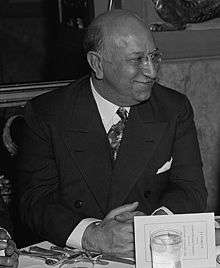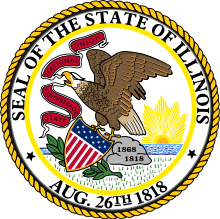Henry Horner
| Henry Horner | |
|---|---|
 Horner in 1937 | |
| 28th Governor of Illinois | |
|
In office January 9, 1933 – October 6, 1940 | |
| Lieutenant |
Thomas Donovan John H. Stelle |
| Preceded by | Louis L. Emmerson |
| Succeeded by | John H. Stelle |
| Personal details | |
| Born |
November 30, 1878 Chicago, Illinois |
| Died |
October 6, 1940 (aged 61) Winnetka, Illinois |
| Political party | Democratic |
| Religion | Judaism |
Henry Horner (November 30, 1878 – October 6, 1940[1]) was the 28th Governor of Illinois, serving from 1933 to 1940, when he died in office. Horner was the first Jewish governor of Illinois.
Political biography
Horner was born Henry Levy to Solomon Abraham Levy and Dilah Horner in Chicago. He assumed the Horner surname after his parents divorced in 1883. He attended the University of Chicago. He was a lawyer and served as a probate judge from 1915 to 1931.
First elected governor in 1932, Horner served during the difficult years of the Great Depression. Because of a fiscal crisis facing Illinois during his first term in office, he was forced to ask the General Assembly for new tax revenue. In 1933, he signed Illinois's first permanent sales tax law into effect with an inaugural rate of 2.0%. Horner also signed a bill in 1935 increasing the Illinois sales tax rate to 3.0%.
Horner's administration was marked by integrity and a strong commitment to both conservative fiscal management and the needs of the indigent and those in state institutions. His insistence on stopping graft and keeping state payrolls free of non-working patronage appointees put him at odds with the Democratic political organization of Chicago run by Patrick Nash and Mayor Ed Kelly. They backed a rival candidate in the 1936 primary, whom Horner defeated with the help of a large downstate vote.
Horner went on to win re-election in November, 1936, whereupon he became determined to defeat the Kelly-Nash machine. He supported the election of Scott Lucas to the Senate in 1938 to succeed retiring incumbent William H. Dieterich, who had proven to be anti-Semitic and somewhat pro-German. Horner suffered a stroke four days before the November election, and spent five months recovering in Florida before returning to Illinois, too late to mount the campaign he had wanted to lead against the re-election of Mayor Kelly.
The Governor's health wavered over the next year until a collapse in the summer of 1940. He convalesced in Winnetka and Highland Park, Illinois from June, 1940 until his death in early October. Horner was succeeded by Lt. Governor John H. Stelle, who had been one of his greatest political enemies.
Horner was a member of Temple B'rith Sholom in Springfield, IL.[2]
Legacies
Horner is interred at Zion Gardens Cemetery in the Mt. Mayriv section, a Jewish cemetery in the Dunning neighborhood of Chicago. A Jewish summer camp in Ingleside, a suburb of Chicago, is named Camp Henry Horner after him.
Horner, a lifelong bachelor, collected memorabilia related to Abraham Lincoln and bequeathed it to the people of Illinois. The Horner Collection is now stored and partly displayed in the Abraham Lincoln Presidential Library and Museum in Springfield, Illinois.
Horner Park, located in Chicago, is a 55-acre (220,000 m2) facility bordered by Montrose Avenue to the north, Irving Park Road to the south, California Avenue to the west, and the north branch of the Chicago River to the east. The Governor Horner State Memorial is located in Horner Park.
The Chicago Housing Authority's now demolished Henry Horner Homes complex on Chicago's near-west side was named in honor of Governor Horner.
Books
- (1969) Thomas B. Littlewood, Horner of Illinois. Northwestern University Press.
- (2007) Charles J. Masters, Governor Henry Horner, Chicago Politics, And The Great Depression. Southern Illinois University Press. ISBN 0-8093-2739-2.
References
- ↑ Masters, Charles J. (2007). Governor Henry Horner, Chicago Politics, And the Great Depression. SIU Press. ISBN 9780809388042.
- ↑ http://www.templebrithsholom.net/about-us/150-years
- This article incorporates facts obtained from: Lawrence Kestenbaum, The Political Graveyard
External links
| Political offices | ||
|---|---|---|
| Preceded by Louis L. Emmerson |
Governor of Illinois 1933–1940 |
Succeeded by John H. Stelle |
